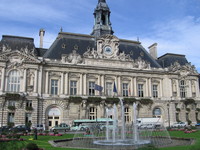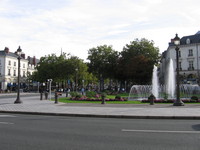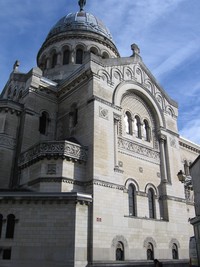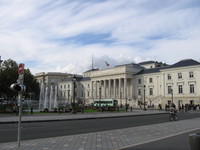Tours
 Deep in the Touraine region, Tours is a bustling cosmopolitan city, thriving business centre and reputedly home to the purest spoken French. The cityâs famous half-timbered and gabled houses and the rich history which lies behind them also make Tours one of Franceâs most popular tourist destinations.
Deep in the Touraine region, Tours is a bustling cosmopolitan city, thriving business centre and reputedly home to the purest spoken French. The cityâs famous half-timbered and gabled houses and the rich history which lies behind them also make Tours one of Franceâs most popular tourist destinations.
The site on which Tours lies has been inhabited since the Roman settlement of Caesarodunum was established there in the first century AD. It became noted during the fourth century as a Christian ecclesiastical centre, largely thanks to the activities of Bishop Martin. Martin had been a Christian missionary who actively converted many parts of France to Christianity, and founded two monasteries in the Touraine region. On his death, miracles were said to have taken place at his tomb, and many people began to visit the cemetery in the hope of curing themselves of sickness and other maladies. Martin was canonised, and a grand basilica was built in his honour â its two stone towers, the Tour Charlemagne and Tour de lâHorloge, still remain on either side of the rue des Halles.
 Gregory was also a famous bishop of Tours, renowned for writing one of the most important texts of Dark Age Europe, the History of the Franks, during the sixth century. The townâs reputation as a centre of learning was particularly bolstered during the Carolingian period when Emperor Charlemagne commissioned the renowned scholar, Alcuin of York, to establish an educational centre there. The fact that the school taught a wide range of subjects and produced a large number of illustrated manuscripts made it virtually unprecedented in the West.
Gregory was also a famous bishop of Tours, renowned for writing one of the most important texts of Dark Age Europe, the History of the Franks, during the sixth century. The townâs reputation as a centre of learning was particularly bolstered during the Carolingian period when Emperor Charlemagne commissioned the renowned scholar, Alcuin of York, to establish an educational centre there. The fact that the school taught a wide range of subjects and produced a large number of illustrated manuscripts made it virtually unprecedented in the West.
Tours later became a centre of royalty, when Louis XI chose to set up his court in the town during the fifteenth century. It was he who first encouraged silk-making among the townspeople, an industry for which Tours became particularly revered; its success gave rise to a large merchant class and general affluence. Toursâ long-term prosperity was shattered during the first and second world wars, and much of the centre was badly bombed during the 1940s. However, from the 1950s economic well-being gradually returned, and the original splendour of the old town was magnificently restored.
Attractions
 Toursâ fascinating history is well conveyed through its many museums. The [http://www.monuments-touraine.fr/page.php?id_noeud=115 Archaeological Museum] provides an excellent history of the Touraine region and contains exhibits from the prehistoric to the eighteenth-century. The Museum of Craftsmanship describes the importance of trade guilds to the townâs history, and the stories of craftsmen as diverse as stonemasons, clogmakers, and barrel-makers. The Museum of Touraine Wine meanwhile explains the regionâs viticultural history, displaying wine-making tools from through the ages and Gallo-Roman and Renaissance winepresses. The Chateau Royal de Tours, a royal residence between the thirteenth and fifteenth centuries, now contains an interesting waxwork museum which explains the history of the Touraine region, whilst the cityâs more unusual and recent association with stained glass is exhibited in the Musée du Gemmail, which contains interpretations of famous artworks.
Toursâ fascinating history is well conveyed through its many museums. The [http://www.monuments-touraine.fr/page.php?id_noeud=115 Archaeological Museum] provides an excellent history of the Touraine region and contains exhibits from the prehistoric to the eighteenth-century. The Museum of Craftsmanship describes the importance of trade guilds to the townâs history, and the stories of craftsmen as diverse as stonemasons, clogmakers, and barrel-makers. The Museum of Touraine Wine meanwhile explains the regionâs viticultural history, displaying wine-making tools from through the ages and Gallo-Roman and Renaissance winepresses. The Chateau Royal de Tours, a royal residence between the thirteenth and fifteenth centuries, now contains an interesting waxwork museum which explains the history of the Touraine region, whilst the cityâs more unusual and recent association with stained glass is exhibited in the Musée du Gemmail, which contains interpretations of famous artworks.
The St Gatien Cathedral is a living representation of Toursâ ecclesiastical history. Built between the thirteenth and fifteenth centuries, the breathtaking building embodies the development of Gothic style â the Flamboyant Gothic façade gives way to a fourteenth-century nave and transept, with a thirteenth-century choir and parts of the former Roman church. Fascinating artwork abounds, including the carvings on the tomb of Charles VIII and Anne of Brittanyâs infant sons from 1499, by Toursâ famous sculptor, Michel de Colombe. St Martin is frequently depicted, most strikingly on a fourteenth-century fresco and on a number of stunning stained glass windows. Also of interest are the remains of the cloister, dating from the fifteenth and sixteenth centuries.
 For art lovers, the Museum of Fine Art â once the archbishopâs palace â contains an astonishing array of works from the Middle Ages to the contemporary. Rubenâs Ex-Voto Of The Virgin and Rembrandtâs The Flight Into Egypt are both housed here, but these are just two of an extensive collection which also includes twentieth-century artists such as Michael Haas, and contains many local landscapes and depictions of Touraine literary figures. The grounds alone, with their immaculate formal French gardens, are well worth a visit.
For art lovers, the Museum of Fine Art â once the archbishopâs palace â contains an astonishing array of works from the Middle Ages to the contemporary. Rubenâs Ex-Voto Of The Virgin and Rembrandtâs The Flight Into Egypt are both housed here, but these are just two of an extensive collection which also includes twentieth-century artists such as Michael Haas, and contains many local landscapes and depictions of Touraine literary figures. The grounds alone, with their immaculate formal French gardens, are well worth a visit.
There are also excellent sporting facilities in the city, including an Olympic-sized swimming pool, an ice rink, football stadium and watersports centre offering numerous activities including kayaking and rowing.
Shopping
All tastes are catered for in the shops of Tours. Large chain stores are situated along the rue Nationale or in one of the many shopping malls, whilst smaller boutiques abound around the old part of town. There are markets every day apart from Monday at various locations across the centre of town, which sell varied produce â from fruit and vegetables, to antiques, to bric-a-brac.
Nightlife and Eating Out
There is an excellent array of restaurants serving traditional French cuisine and local specialities such as tripe, St Maure goatâs cheese, prunes and goose pâté. Chic bars and clubs are packed into the area around Place Plumereau. There are numerous cinemas and theatres, an [http://www.parc-expositions.com exhibitions hall], the National Dance Centre, and contemporary music clubs such as Le Petit Faucheux and [http://www.bateau-ivre.org Le Bateau Ivre]. Of particular note is the cityâs commitment to classical music â churches around Tours regularly put on concerts, and there are choral singing and chamber music festivals during May and June.
Tourist Information
Office de Tourisme, 78-82 Rue Bernard Palissy,BP 4201,37042 Tours Cedex
- +33 2 47 70 37 37
- [http://www.ligeris.com www.ligeris.com]
Airport
Ryanair flies direct from London Stansted to Toursâ Loire Valley airport, where a shuttle bus offers a connection to the central railway station. There are also several airports located in Paris, only one hour away by train. The A10 motorway â the main route from Paris to Bordeaux â also cuts almost directly through Tours. 
Popular car hire locations in France
All car hire locations in France
- Abbeville

- Abbeville-Buigny-Saint-Maclou Airport

- Abidos

- Agen

- Agen-La Garenne Airport

- Agora Helipad Airport

- Aix-En-Provence

- Aix-Les-Bains

- Ajaccio

- Ajaccio-Napoléon Bonaparte Airport

- Albertville

- Albi

- Albi-Le Séquestre Airport

- Alençon

- Alfortville

- Alixan

- Alès

- Amboise

- Ambérieu-En-Bugey

- Amiens

- Amiens-Glisy Airport

- Ancenis

- Andernos-Les-Bains

- Angers

- Angers-Loire Airport

- Anglet

- Angoulême

- Angoulême-Brie-Champniers Airport

- Annecy

- Annecy-Haute-Savoie-Mont Blanc Airport

- Annemasse

- Annonay

- Antibes

- Arcachon

- Arcachon-La Teste-De-Buch Airport

- Argelers

- Arles

- Arras

- Ars-En-Ré

- Aubagne

- Aubenas-Ardèche Méridional Airport

- Aubergenville

- Auch

- Aulnay-Sous-Bois

- Auray

- Aurillac

- Aurillac Airport

- Auxerre

- Auxerre-Branches Airport

- Avallon

- Avignon

- Avignon-Caumont Airport

- Avoine

- Avranches

- Bagnolet

- Bailleul

- Bandol

- Bastia

- Bastia-Poretta Airport

- Bayeux

- Bayonne

- Beaulieu-Sur-Mer

- Beaune

- Beauvais

- Belfort

- Bellegarde-Sur-Valserine

- Bergerac

- Bergerac-Roumanière Airport
- Bernay

- Besançon

- Bezannes

- Bezons

- Biarritz

- Biarritz-Anglet-Bayonne Airport

- Biganos

- Billère

- Biscarrosse

- Blagnac

- Blain

- Blaye

- Blois

- Bobigny

- Boissy-Saint-Léger

- Bolquère

- Bondy

- Bonifacio

- Bordeaux

- Bordeaux-Mérignac (ba 106) Airport

- Boulogne-Billancourt

- Boulogne-Sur-Mer
- Bourbourg

- Bourg-En-Bresse

- Bourg-Lès-Valence

- Bourg-Saint-Maurice

- Bourges

- Bourges Airport

- Bourgoin-Jallieu

- Boves

- Brest

- Brest Bretagne Airport

- Briançon

- Brignais

- Brignoles

- Brive-La Roche Airport

- Brive-La-Gaillarde

- Béthune

- Béziers

- Béziers-Vias Airport

- Caen

- Caen-Carpiquet Airport

- Cagnes-Sur-Mer
- Cahors

- Calais

- Calais-Dunkerque Airport

- Calvi

- Calvi-Sainte-Catherine Airport

- Cambrai

- Camon

- Canet-En-Roussillon

- Cannes

- Cannes-Mandelieu Airport

- Carcassonne

- Carcassonne Airport

- Carentoir

- Carpentras

- Carros
- Castelsarrasin

- Castets

- Castres

- Castres-Mazamet Airport

- Castries
- Caudebec-En-Caux

- Cavaillon

- Cavalaire-Sur-Mer

- Cesson-Sévigné

- Chalon-Sur-Saône

- Chalonnes-Sur-Loire

- Chambray-Lès-Tours

- Chambéry

- Chambéry-Savoie Airport

- Chamonix-Mont-Blanc

- Chaponnay

- Charles De Gaulle International Airport

- Charleville-Mézières

- Chartres

- Chaumont

- Chauvigny-Du-Perche

- Chelles

- Cherbourg-Maupertus Airport

- Chessy-Les-Prés

- Chevilly-Larue

- Cholet

- Cholet Le Pontreau Airport

- Châlons-En-Champagne

- Châlons-Vatry Air Base Airport

- Château-Thierry

- Châteaubriant

- Châteaudun

- Châteauroux

- Châteauroux-Déols "Marcel Dassault" Airport

- Châtellerault

- Clermont-Ferrand

- Clermont-Ferrand Auvergne Airport

- Clichy-Sous-Bois

- Cluses

- Cognac

- Cognac-Châteaubernard (ba 709) Air Base Airport

- Coignières

- Colmar

- Colmar-Houssen Airport

- Colombes

- Compiègne

- Concarneau

- Corbeil-Essonnes

- Cordemais

- Corte

- Cosne-Cours-Sur-Loire

- Courchevel

- Courchevel 1550

- Courchevel Airport

- Creil

- Creil Air Base Airport

- Croisette Airport

- Créteil

- Dammarie-Les-Lys

- Dardilly

- Dax

- Deauville

- Deauville-Saint-Gatien Airport

- Decazeville

- Dieppe

- Digne-Les-Bains

- Dijon

- Dijon-Bourgogne Airport

- Dinan

- Dinard-Pleurtuit-Saint-Malo Airport

- Disneyland Paris Airport

- Dives-Sur-Mer

- Dole

- Dole-Tavaux Airport

- Dordives

- Douai

- Draguignan

- Dunkerque

- Egletons

- Els Banys D'Arles
- Eu

- Euroairport

- Euroairport Basel-Mulhouse-Freiburg

- Fain-Lès-Moutiers

- Figari Sud-Corse Airport

- Figeac

- Flers

- Fleury-Les-Aubrais

- Foix

- Font-Romeu-Odeillo-Via

- Fontainebleau

- Fontenay-Le-Comte

- Forbach

- Frejus Airport

- Fromentine

- Frontignan

- Fréjus

- Gap

- Gap - Tallard Airport

- Gevrey-Chambertin

- Ghisonaccia

- Gien

- Givet

- Gouesnou

- Gradignan

- Granville

- Granville Airport

- Grasse

- Gray

- Grenoble

- Grenoble-Isère Airport

- Gueugnon

- Guingamp

- Guéret

- Haguenau

- Ham-Sur-Meuse

- Heliport Airport

- Hendaye

- Hirson

- Hyères

- Hénin-Beaumont

- Issoire

- Jarnac

- Joigny

- Jonzac

- Juan Les Pins Airport

- Juan-Les-Pins

- L'Île-Rousse
- La Baule-Escoublac

- La Baule-Escoublac Airport

- La Chapelle-Saint-Luc

- La Ciotat

- La Croix-Valmer

- La Defense Heliport Airport

- La Ferté-Bernard

- La Flèche

- La Grande-Motte

- La Haie-Fouassière

- La Moncelle

- La Môle Airport

- La Palmyre

- La Plaine-Saint-Denis

- La Roche-Sur-Yon

- La Roche-Sur-Yon Airport

- La Rochelle

- La Rochelle-Île De Ré Airport

- La Seyne-Sur-Mer

- La Tranche-Sur-Mer

- La Tremblade

- La Valette-Du-Var

- La Vallée De Dormelles

- Landerneau

- Lanester

- Langon

- Lannemezan

- Lannion

- Lannion-Côte De Granit Airport

- Laon

- Laval

- Laval-Entrammes Airport

- Le Bourget

- Le Bouscat

- Le Cannet

- Le Cap D'Agde
- Le Creusot

- Le Havre

- Le Havre Octeville Airport

- Le Lavandou

- Le Luc

- Le Mans

- Le Mans-Arnage Airport

- Le Passage

- Le Pecq

- Le Puy-En-Velay

- Le Puy-Loudes Airport

- Le Touquet-Côte D'Opale Airport
- Le Touquet-Paris-Plage
- Lens

- Les Arcs

- Les Herbiers

- Les Mureaux

- Les Sables-D'Olonne
- Les Sables-D'Olonne Talmont Airport
- Les Ulis

- Lesparre-Médoc

- Levallois-Perret

- Libourne

- Lille

- Lille-Lesquin Airport

- Limoges

- Limoges Airport

- Lisieux

- Longwy

- Lons-Le-Saunier

- Lorient

- Lorient South Brittany (bretagne Sud) Airport

- Loriol-Sur-Drôme

- Lourdes

- Louviers

- Louvigny

- Louvroil

- Ludres

- Luisant

- Lumio

- Lunéville

- Lure

- Luxeuil-Les-Bains

- Luçon

- Lyon

- Lyon Saint-Exupéry Airport

- Lyon-Bron Airport

- Lys-Lez-Lannoy

- Lézignan-Corbières

- Macinaggio

- Magenta

- Maisons-Alfort

- Malakoff

- Manosque

- Mantes-La-Jolie

- Marans

- Marmande

- Marseillan

- Marseille

- Marseille Provence Airport

- Martigues

- Massy

- Maubeuge

- Mazamet

- Meaux

- Megève

- Megève Airport

- Melle

- Melun

- Menton

- Metz

- Metz-Frescaty (ba 128) Air Base Airport

- Metz-Nancy-Lorraine Airport

- Migennes

- Millau

- Mimizan

- Mimizan-Plage

- Mont-De-Marsan

- Montargis

- Montauban

- Montauroux

- Montbard

- Montbéliard

- Montchanin

- Montereau-Fault-Yonne

- Montigny-Le-Bretonneux

- Montluçon

- Montluçon-Domérat Airport

- Montpellier

- Montpellier-Méditerranée Airport

- Montreuil

- Montrouge

- Montélimar

- Montévrain

- Morangis

- Morlaix

- Morlaix-Ploujean Airport

- Morteau

- Morzine

- Moulins

- Mulhouse

- Mâcon

- Méribel

- Méribel Airport

- Mérignac

- Nancy

- Nancy-Essey Airport

- Nanterre

- Nantes

- Nantes Atlantique Airport

- Narbonne

- Neuilly-Sur-Seine

- Nevers

- Nevers-Fourchambault Airport

- Nice

- Nice-Côte D'Azur Airport
- Niort

- Niort-Souché Airport

- Nogent-Le-Rotrou

- Nogent-Sur-Marne

- Nogent-Sur-Oise

- Noirmoutier-En-L'Île
- Noisy-Le-Grand

- Nérac

- Nîmes

- Nîmes-Arles-Camargue Airport

- Olivet

- Orange

- Orgeval

- Orléans

- Orvault

- Oyonnax

- Paimpol

- Pamiers

- Paris

- Paris Beauvais Tillé Airport

- Paris Issy-Les-Moulineaux Airport

- Paris-Le Bourget Airport

- Paris-Orly Airport

- Parthenay

- Pau

- Pau Pyrénées Airport

- Perpignan

- Perpignan-Rivesaltes (llabanère) Airport

- Pertuis

- Pierrelatte

- Pierrelaye

- Pithiviers

- Ploërmel

- Poissy

- Poitiers

- Poitiers-Biard Airport

- Poligny

- Pont-Audemer

- Pont-à-Mousson

- Pontarlier

- Pontcharra

- Pontchâteau

- Pontivy

- Pontoise

- Pontoise - Cormeilles-En-Vexin Airport

- Pornic

- Porticcio

- Porto-Vecchio

- Pouldergat

- Pouzauges

- Prades

- Propriano

- Propriano Airport

- Provins

- Périgueux

- Périgueux-Bassillac Airport

- Quimper

- Quimper-Cornouaille Airport

- Rambouillet

- Ramonville-Saint-Agne

- Redon

- Reims

- Reims-Champagne (ba 112) Airport

- Rennes

- Rennes-Saint-Jacques Airport

- Revigny-Sur-Ornain

- Revin

- Riedisheim

- Rillieux-La-Pape

- Roanne

- Roanne-Renaison Airport

- Rochefort

- Rochefort-Saint-Agnant (ba 721) Airport

- Rodez

- Rodez-Marcillac Airport

- Roissy-En-Brie

- Romorantin-Lanthenay

- Roscoff

- Rouen

- Rouen Airport

- Royan

- Royan-Médis Airport

- Rueil-Malmaison

- Ruffec

- Ruffec, Charente

- Rungis

- Sagone

- Saint-Avold

- Saint-Brieuc

- Saint-Brieuc-Armor Airport

- Saint-Claude

- Saint-Claude-De-Diray

- Saint-Denis

- Saint-Dizier

- Saint-Dié-Des-Vosges

- Saint-Florent

- Saint-Florentin

- Saint-Gaudens

- Saint-Geoirs

- Saint-Georges-D'Oléron
- Saint-Germain-En-Laye

- Saint-Gilles-Croix-De-Vie
- Saint-Herblain

- Saint-Jean-D'Angély
- Saint-Jean-De-Maurienne

- Saint-Lô

- Saint-Malo

- Saint-Marcel-Lès-Valence

- Saint-Maur-Des-Fossés

- Saint-Nazaire

- Saint-Nazaire-Montoir Airport

- Saint-Omer

- Saint-Ouen

- Saint-Ouen-L'Aumône
- Saint-Pierre-Des-Corps

- Saint-Quentin

- Saint-Raphaël

- Saint-Savin

- Saint-Senier-Sous-Avranches

- Saint-Sulpice-Sur-Risle

- Saint-Thibault-Des-Vignes

- Saint-Tropez

- Saint-Vulbas

- Saint-Étienne

- Saint-Étienne-Bouthéon Airport

- Sainte-Maxime

- Saintes

- Saintes-Maries-De-La-Mer

- Sallanches

- Salon-De-Provence

- Santa-Lucia-Di-Moriani

- Sarlat-La-Canéda

- Sarre-Union

- Sarrebourg

- Sarreguemines

- Saumur

- Saverne

- Sedan

- Sens

- Serquigny

- Serre Chevalier Airport

- Seynod

- Soissons

- Solenzara

- Sommesous

- Sophia Antipolis

- Sophia Antipolis Airport

- Soulosse-Sous-Saint-Élophe

- St Aubin Airport

- Strasbourg

- Strasbourg Airport

- Sully-Sur-Loire

- Surgères

- Sète

- Sélestat

- Tarbes

- Tarbes-Lourdes-Pyrénées Airport

- Tavaux

- Tavers

- Thiers

- Thionville

- Thonon-Les-Bains

- Thouars

- Tignes

- Tinqueux

- Torcy

- Toul

- Toulon

- Toulon-Hyères Airport

- Toulouse

- Toulouse-Blagnac Airport

- Tourlaville

- Tours

- Tours-Val-De-Loire Airport

- Toussus-Le-Noble Airport

- Trappes

- Tresses

- Trignac

- Troyes

- Uzès

- Val-D'Isère
- Valence

- Valence-Chabeuil Airport

- Valenciennes

- Valentigney

- Valenton

- Valréas

- Vannes

- Vannes-Meucon Airport

- Varennes-Sur-Seine

- Vaulx-En-Velin

- Veauche

- Vendôme

- Verdun

- Vernon

- Versailles

- Vertou

- Vesoul

- Vichy

- Vichy-Charmeil Airport

- Vienne

- Vierzon

- Villefranche-Sur-Saône

- Villeneuve-D'Ascq
- Villeneuve-Loubet
- Villeneuve-Sur-Lot

- Viriat

- Viroflay

- Viry-Châtillon

- Vitrolles

- Vitry-Le-François

- Vitré

- Vélizy-Villacoublay

- Vénissieux

- Yutz

- Échirolles

- Écully

- Épernay

- Épinal

- Épinay-Sur-Seine

- Étampes

- Évreux

- Évry




